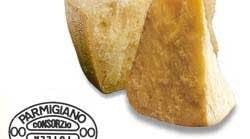It's certainly not true that all good things in life originate in Italy - just most of them. Art, music, fashion - all the components of la dolce vita. And cheese! Especially the king of cheeses, Parmigiano-Reggiano.
What makes it so admired and adored is the same as what makes true Champagne superior to other fizzy wannabes: the quality of ingredients, the terrain where they're produced (and protected by law from pretenders) and the skill and passion of the dedicated artisans who craft the product.
You've tasted the knock-offs, or (shudder!) the treated, sawdust-like facsimiles in the little cardboard canisters. A lot goes into making the genuine Parmigiano-Reggiano, with its uniquely sweet and nutty flavor and the creamy, yet crackly texture that's heaven to the palate.
Real Parmigiano is made only in the province of Parma, of highest-quality milk from local cows fed grasses grown only in the neighborhood - no silage or additives (all strictly prohibited by law). The cows are milked twice daily and the milk delivered to a nearby cheese plant within two hours.
Then there's the laborious, centuries-old creation process passed down through generations and carried out by hand by the cheese maker. There's nothing mass-produced or industrialized about this procedure, which, just as with true Champagne, requires the maker's daily assessments, carried out by touch and sight, to react to particular conditions - "A mindful process," intoned the artisan I watched with awe as the morning milk arrived and he leaped into action, checking first to assure the temperature was absolutely perfect.
The milk from the evening's milking awaits the morning batch. Overnight, cream has risen to the top and is partially skimmed away. This milk is poured into copper cauldrons where it's mixed with the morning milk. Then, a natural whey starter (obtained from the previous day's production) is added, along with natural calves' rennet to incite the milk to curdle. It takes four gallons milk for every two pounds of cheese. This means 160 gallons will go into each of the 80-lb. wheels.
The master cheese maker then takes a huge whisk and stirs the cauldron's contents to break the curds down into tiny granules. To expel water from these granules, the cheese maker gently heats the milk until, by touch - dipping, squeezing, evaluating, as if his life, not least his livelihood and reputation, depended on it - he knows it's ready. The granules sink to the bottom and cling together.
Then comes the heavy lifting. Two men, working together, wrestle this huge mass into cheesecloth, dividing it in two with a swift slice and placing each part in a special mold, where it rests for a few days. (This is the time the cheese is marked with a stamp recording month and year it's made and the unique, burned-in pin-dots that identify it as real Parmigiano-Reggiano.)
Next, the wheels lounge in a salt solution for close to 20 days to flavor the cheese and start the long aging that lets the cheese develop its special fragrance and flavor. This is a process (again, dictated by law) that requires a full two years.
Instant gratification? Mi scusi, signora, but you've gotta wait.
Parmigiano may sometimes seem a bit more expensive than look-alikes (although, pound for pound, the difference can be negligible when compared with products that use fillers). But true Parmigiano also employs superior milk, lots of hand labor and careful aging.
Parmigiano-Reggiano is also a healthful product, easily digestible (for many Italian infants it is one of the first-introduced solid foods) and a superior source of protein, amino acids, calcium and phosphorous. It contains more vitamins and minerals than most meat protein. And because it's made from partially-skimmed milk, it's one of the lowest in fat and cholesterol of any aged natural cheese. One tablespoon, freshly grated over pasta, risotto, soup or salad, adds only 1.5 g fat and all of 4 mg cholesterol.


